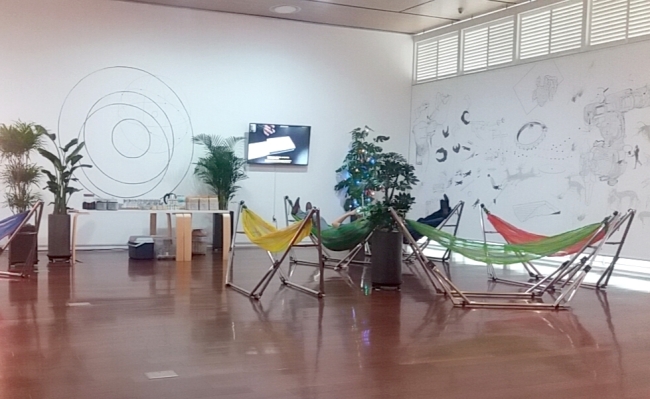Over a dozen Vietnamese and Korean artists and art groups have gathered for an exhibition looking at the rapid changes the two countries have experienced in recent decades.
Hosted by the Korea Foundation to mark the 25th anniversary of ties, “Salt of the Jungle” examines the results of their sometimes destructive urbanization, industrialization and migration.
The title of the exhibition is borrowed from the novel by the Vietnamese writer Nguyen Huy Thiep, in which it refers to a flower as white as salt that blooms only once in 30 years.
In the novel, an elderly man hunting a monkey is shocked when he sees its distressed mate trying to save it. Unable to ignore the human-like behavior of the monkeys, the hunter eventually curses and gives up. Heading home, he sees the flower -- a sign of peace and prosperity.
Whether this is supposed to be a metaphor for a conflation of destruction with prosperity, or the realization that the two are not necessarily linked is not clear. This ambiguity is held up as a reflection of the situation facing Vietnamese who have grown up in the wake of the country’s economic reforms of the 1980s.
The Korean and Vietnamese artists in the exhibition explore the effects of the two countries’ rapid development -- regretting the loss of timeworn traditions while valuing the resulting affluence.
Art Labor Collective has turned the back area of the exhibition into “Jarai Dew” a hammock cafe styled on those commonly found at rest areas on Vietnamese highways.
The Jarai are an ethnic minority in Vietnam’s central highlands, where Art Labor says modernization and migration have had a huge impact on politics and culture, and the title of the work references the Jarai concept of what happens after death.
“Most people think that after they die they go to heaven but Jarai don’t believe they go to heaven but go through stages of transformation,” said Art Labor curator Arlett Qyunh-Anh Tran.
“The last stage is dew, which evaporates into the environment. We think it’s a very special way of looking at life.”
And fellow Art Labor member Thao-Nguyen Phan sees parallels between these stages of transformation and the modernization and development of society.
“It’s beautiful being transformed into insects or birds, but it’s also violent, because in order to transform, you have to be completely destroyed,” she said.

Jarai Dew” by Art Labor Collective
It’s a somewhat sprawling installation, encompassing the work of other artists, with the effect that it is unclear where exactly it stops.
The work itself transforms each time it relocates, as local artists’ work is included.
Local video artists’ work is shown as part of the installation, reflecting the large TV screens at real-life hammock rest stations.
One video shows snippets of modern Korean life, which Art Labor were partly drawn to because of the continuation of very old traditions -- animism in apartment blocks and women who believe touching a phallic rock will help them conceive.
Another, “21st Century Light of the Factory” by Mixrice reflects another continuation of tradition, this time changing as it is passed on. It shows a reworking of a 1970s factory workers play, “Light of the Factory” that was later recreated by Maseok Migrant Theatre, a now-defunct drama group by migrant workers in a furniture factory. Mixrice then filmed a new set of migrant, irregular and dismissed factory workers performing a new play with specially written songs inspired by the previous work.
The topic of Migration is found elsewhere in the exhibition. In “Tomorrow I Leave,” Lin+Lam superimposes words from postcards sent by a migrant retracing his journey out of Vietnam over videos of harbor water, the lack of horizon creating a sense of uncertainty over the end-point of migration.
Among the other work in the show, several pieces look at other aspects of transformation through everyday things.
The Propeller Group looks at the tire tracks of Vietnam’s ubiquitous scooters as a form of expression, while Jo Hye-jin conducts a meticulous inquiry into the artificial palm leaves used in flower displays. Exploring their origins and evolution, Jo discovers the complicated interactions of culture, history and capital in a mundane object, and unravels it in a chain of “sculptural forms.”
“Salt of the Jungle” is open at the KF Gallery in the Mirae Asset building in Jung-gu Seoul until Oct. 18. Guided tours are available throughout the week and tours in Vietnamese are available on Saturdays. See www.kf.or.kr for details.
By Paul Kerry (paulkerry@heraldcorp.com)






